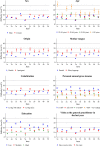National indicators of health literacy: ability to understand health information and to engage actively with healthcare providers - a population-based survey among Danish adults
- PMID: 25339154
- PMCID: PMC4286937
- DOI: 10.1186/1471-2458-14-1095
National indicators of health literacy: ability to understand health information and to engage actively with healthcare providers - a population-based survey among Danish adults
Abstract
Background: Health literacy is a multidimensional concept covering a range of cognitive and social skills necessary for participation in health care. Knowledge of health literacy levels in general populations and how health literacy levels impacts on social health inequity is lacking. The primary aim of this study was to perform a population-based assessment of dimensions of health literacy related to understanding health information and to engaging with healthcare providers. Secondly, the aim was to examine associations between socio-economic characteristics with these dimensions of health literacy.
Methods: A population-based survey was conducted between January and April 2013 in the Central Denmark Region. Postal invitations were sent to a random sample of 46,354 individuals >25 years of age. Two health literacy dimensions were selected from the Health Literacy Questionnaire (HLQ™): i) Understanding health information well enough to know what to do (5 items), and ii) Ability to actively engage with health care providers (5 items). Response options ranged from 1 (very difficult) to 4 (very easy). We investigated the level of perceived difficulty of each task, and the associations between the two dimensions and socio-economic characteristics.
Results: A total of 29,473 (63.6%) responded to the survey. Between 8.8%, 95% CI: 8.4-9.2 and 20.2%, 95% CI: 19.6-20.8 of the general population perceived the health literacy tasks as difficult or very difficult at the individual item level. On the scale level, the mean rating for i) understanding health information was 3.10, 95% CI: 3.09-3.10, and 3.07, 95% CI: 3.07-3.08 for ii) engagement with health care providers. Low levels of the two dimensions were associated with low income, low education level, living alone, and to non-Danish ethnicity. Associations with sex and age differed by the specific health literacy dimension.
Conclusion: Estimates on two key dimensions of health literacy in a general population are now available. A substantial proportion of the Danish population perceives difficulties related to understanding health information and engaging with healthcare providers. The study supports previous findings of a socio-economic gradient in health literacy. New insight is provided on the feasibility of measuring health literacy which is of importance for optimising health systems.
Figures

References
-
- Jordan JE, Osborne RH. Chronic disease self-management education programs: challenges ahead. Med J Aust. 2007;186(2):84–87. - PubMed
Pre-publication history
-
- The pre-publication history for this paper can be accessed here: http://www.biomedcentral.com/1471-2458/14/1095/prepub
Publication types
MeSH terms
LinkOut - more resources
Full Text Sources
Other Literature Sources
Medical
Miscellaneous

